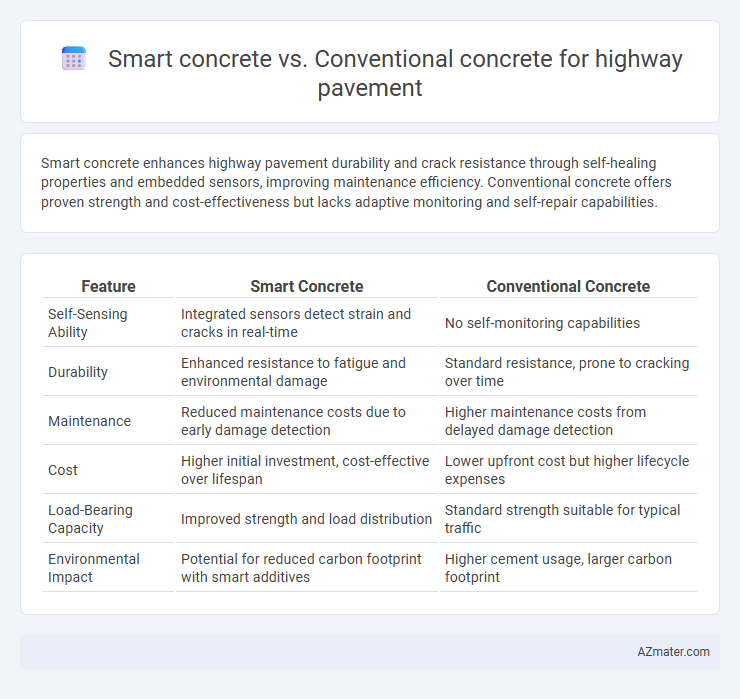Smart concrete enhances highway pavement durability and crack resistance through self-healing properties and embedded sensors, improving maintenance efficiency. Conventional concrete offers proven strength and cost-effectiveness but lacks adaptive monitoring and self-repair capabilities.
Table of Comparison
| Feature | Smart Concrete | Conventional Concrete |
|---|---|---|
| Self-Sensing Ability | Integrated sensors detect strain and cracks in real-time | No self-monitoring capabilities |
| Durability | Enhanced resistance to fatigue and environmental damage | Standard resistance, prone to cracking over time |
| Maintenance | Reduced maintenance costs due to early damage detection | Higher maintenance costs from delayed damage detection |
| Cost | Higher initial investment, cost-effective over lifespan | Lower upfront cost but higher lifecycle expenses |
| Load-Bearing Capacity | Improved strength and load distribution | Standard strength suitable for typical traffic |
| Environmental Impact | Potential for reduced carbon footprint with smart additives | Higher cement usage, larger carbon footprint |
Introduction to Highway Pavement Materials
Smart concrete incorporates sensors and self-healing properties that enhance durability and reduce maintenance in highway pavement applications, outperforming conventional concrete which relies on traditional aggregates and cement mixtures. The integration of nanomaterials and conductive fibers in smart concrete improves crack detection and structural health monitoring, enabling real-time data collection for proactive infrastructure management. Conventional concrete remains widely used due to its cost-effectiveness and established performance, but lacks the advanced functionalities that make smart concrete a promising innovation for modern highway pavement systems.
What is Smart Concrete?
Smart concrete incorporates advanced materials such as carbon fibers, conductive polymers, or sensors to enable self-monitoring and enhanced durability, offering real-time data on structural health for highway pavement applications. Unlike conventional concrete, which relies solely on mechanical strength and external inspections, smart concrete provides active feedback on stress, temperature, and crack formation, improving maintenance efficiency and safety. This technology reduces lifecycle costs and extends pavement service life by enabling proactive repairs based on precise condition monitoring.
Understanding Conventional Concrete
Conventional concrete for highway pavement primarily consists of cement, water, aggregates, and admixtures, providing high compressive strength and durability. This traditional material offers reliable load-bearing capacity and resistance to weathering but often faces challenges like cracking and long curing times. Understanding its composition and performance characteristics is essential for comparing it with innovative alternatives such as smart concrete technologies.
Key Properties of Smart Concrete
Smart concrete for highway pavement features enhanced durability, self-sensing capabilities, and improved crack resistance compared to conventional concrete. Its embedded sensors enable real-time monitoring of stress, temperature, and structural health, leading to proactive maintenance and extended pavement lifespan. The integration of nanomaterials and conductive fibers enhances mechanical strength and electrical conductivity, making smart concrete a superior choice for intelligent infrastructure.
Performance Comparison: Smart vs Conventional Concrete
Smart concrete incorporates embedded sensors and self-healing properties that enhance durability and real-time monitoring capabilities, whereas conventional concrete lacks these advanced features. The integration of smart technology enables early detection of cracks and reduces maintenance costs through timely repairs, significantly extending the pavement's lifespan. Conventional concrete, while structurally sound, often suffers from undetected deterioration leading to costly and frequent maintenance.
Durability and Longevity in Highway Applications
Smart concrete, embedded with sensors and self-healing properties, significantly enhances durability and longevity in highway pavement by detecting early damage and autonomously repairing micro-cracks, reducing maintenance costs and extending service life. Conventional concrete, while cost-effective initially, is more susceptible to cracking, freeze-thaw cycles, and environmental stress, leading to frequent repairs and reduced pavement lifespan. Studies show smart concrete pavements can increase durability by up to 40%, making them a superior choice for sustainable highway infrastructure.
Maintenance and Lifecycle Costs Analysis
Smart concrete integrated with sensors enables real-time monitoring of highway pavement conditions, significantly reducing maintenance costs through predictive maintenance strategies. Conventional concrete often incurs higher lifecycle costs due to delayed damage detection and reactive repairs. Lifecycle cost analysis shows smart concrete extends pavement service life by up to 30%, optimizing budget allocation for long-term infrastructure management.
Sustainability and Environmental Impact
Smart concrete for highway pavement incorporates embedded sensors and adaptive materials to monitor structural health, significantly reducing maintenance frequency and resource consumption compared to conventional concrete. This technology lowers carbon footprint by optimizing material use and enabling early damage detection, which minimizes repair-related emissions and waste. Conventional concrete production generates high CO2 emissions and involves energy-intensive processes without real-time monitoring capabilities, leading to less sustainable pavement infrastructure over its lifecycle.
Challenges in Adopting Smart Concrete
Smart concrete for highway pavement faces significant challenges including high initial costs and complex installation processes compared to conventional concrete, which limits widespread adoption. The integration of sensors and embedded electronics requires specialized maintenance and durability assurances to withstand harsh environmental conditions and heavy traffic loads. Data management and interoperability with existing infrastructure systems remain critical hurdles, hindering seamless implementation in large-scale highway projects.
Future Trends in Highway Pavement Technology
Smart concrete integrates sensors and self-healing properties that enhance durability and real-time monitoring, reducing maintenance costs and improving safety in highway pavement. Conventional concrete, while widely used for its strength and cost-effectiveness, lacks these advanced functionalities, often leading to more frequent repairs and longer service interruptions. Future trends emphasize the adoption of smart concrete embedded with IoT technology and adaptive materials to optimize pavement lifespan and performance under varying traffic and environmental conditions.

Infographic: Smart concrete vs Conventional concrete for Highway pavement
 azmater.com
azmater.com